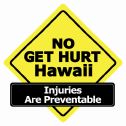
Violence and abuse can take many forms. They range from intimate partner violence, sexual assault, child maltreatment and elder abuse to bullying, school violence and hate crimes. These different forms of violence and abuse are often addressed independently even though they share common risk factors and prevention strategies.
Violence and Abuse Prevention Basics
Why is violence and abuse prevention important?
Violence and abuse is a major public health problem in Hawaii – 168KB. Although assaults are the ninth leading cause of fatal injuries among Hawaii residents, they are the sixth leading cause of nonfatal emergency department visits, and the fourth leading cause of nonfatal hospital admissions.
Violence and Abuse Prevention Details
Data
Please refer to the updated 2008-2012 summary on homicides and assaults (18 KB) for more detail.
For the full chapter on homicides and assaults (PDF 1 MB) refer to the Databook (Injuries in Hawaii 2007-2011).
Strategy
In 2010, the Needs Assessment on Violence and Abuse Prevention in Hawaiʻi (801KB) was conducted that included an online survey of 149 people representing government agencies, law enforcement, schools and universities, medical centers, nonprofit organizations, private businesses, and grassroots organizations; and qualitative interviews with 21 key informants from state agencies and universities. A cross-disciplinary stakeholder group was convened to review the results and recommendations, and assess whether they reflected the potential for measurable progress and impact over the next five years. The results of the needs assessment was used to inform the violence prevention recommendations for the Hawaiʻi Injury Prevention Plan. For more detail, please refer to the violence and abuse prevention recommendations (PDF 475 KB) in the 2012-2017 Hawaiʻi Injury Prevention Plan (HIPP).
Projects
The Hawai‘i State Department of Health, Maternal and Child Health Branch (MCHB) leads activities in the state to prevent intimate partner violence, sexual assault, and child maltreatment, with support from the Injury Prevention and Control Section (IPCS) and other partners in the community. IPCS has been specifically involved with bullying prevention and also leads activities in the state in suicide prevention.
Community Collaboration
- Child Death Review Council
- Domestic Violence Fatality Review
- Hawai‘i Children’s Trust Fund Advisory Council
- Hawai‘i Coalition Against Sexual Assault
- Hawai‘i Community Foundation
- Hawai‘i Youth Services Network
- Hawai‘i State Department of Education, School Based Behavioral Health
- Hawai‘i State Department of Health, Family Health Services Division, Maternal and Child Health Branch
- Hawai‘i State Department of Human Services
- Hawai‘i State Department of the Attorney General
- Hawai‘i State Judiciary, Children’s Justice Center and First Circuit Court
- Ho‘oikaika Partnership
- Injury Prevention Advisory Committee (IPAC)
- Maui County Domestic Violence Task Force
- University of Hawai‘i, John A. Burns School of Medicine, Department of Psychiatry
- University of Hawai‘i, Social Science Research Institute
Resources and Links
Local
The vision of the Joyful Heart Foundation is a community with no sexual assault, domestic violence and child abuse. Our mission is to heal, educate and empower survivors of sexual assault, domestic violence and child abuse, and to shed light into the darkness that surrounds these issues.
Domestic Violence Action Center
The Domestic Violence Action Center is dedicated to alleviating the problem of domestic abuse in Hawaii. It is the only agency in the State that accepts large numbers of high-risk divorce, temporary restraining order, post-decree and paternity cases. It is also the only agency in the community with a full complement of services to assist as a victim navigates the system and moves her (his) life to freedom and self-sufficiency.
Hawaii State Coalition Against Domestic Violence
The HSCADV is a private, not-for-profit organization and is a statewide partnership of domestic violence programs and shelters. It is also a clearinghouse of domestic violence information and materials ranging from files to videos and manuals.
The Sex Abuse Treatment Center (SATC) of the Kapi’olani Medical Center for Women and Children (KMCWC) is a statewide program valued for its leadership and expertise in providing treatment services for survivors of sexual assault, preventing sexual violence and effecting change through public policy, awareness and education. SATC’s hotline # is 808-524-7273 (808-524-RAPE).
Hawaii Domestic Violence Services
Is a one-stop on-line information service for victims and families of sexual assault and domestic violence in Hawai`i County.
National
RAINN (Rape, Abuse, & Incest National Network)
RAINN is the nation’s largest anti-sexual violence organization and was named one of “America’s 100 Best Charities” by Worth magazine. RAINN created and operates the National Sexual Assault Hotline (800.656.HOPE and online.rainn.org) in partnership with more than 1,100 local rape crisis centers across the country and operates the DoD Safe Helpline for the Department of Defense. RAINN also carries out programs to prevent sexual violence, help victims and ensure that rapists are brought to justice.
The Center for Disease Control, Division of Violence Prevention (DVP) is committed to stopping violence before it begins (i.e., primary prevention) by conducting research on effective strategies and programs and helping state and local partners implement and evaluate prevention programs.
Veto Violence is a new online violence education tool developed by DVP. Violence is problem with a solution. It can be prevented by using a thoughtful and systematic approach. While the field of violence prevention is still developing, our knowledge of “what works” increases every day.

